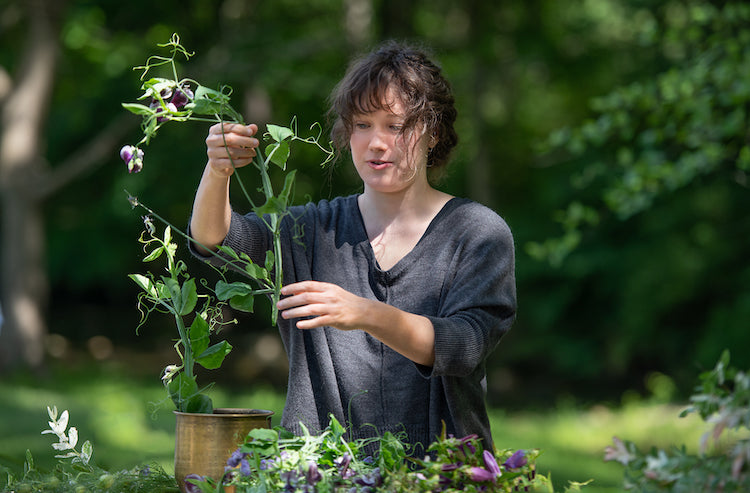Too often, people think that cut flowers need to be perfect to be displayed. Many perceive that if a stem bends, a petal droops, or an arrangement begins to look a bit, well, tired – that it must be time to toss it.
I beg to differ. Cut flowers are remarkably resilient. They can be restored, and their lives can be extended with the benefit of a little basic knowledge of botanical biology. While it is true that freshly cut flowers for display in a vase do whither in time, this is no reason not to gift oneself a little transient beauty – to capture, even for a time, this loveliness. There are ways to extend what the poet, William Wordsworth described as the glory in the flower.

Pro tips to extend your cut flowers:
- When placing stems in water, ensure that the stems are clean (dirt and leaf free). Cleaner stems create less debris in the water. This is important because with less debris (a vase is an ecosystem of sorts) less decomposition will occur.
- Vases should be filled with as much water as possible, and the clean stems should then be placed in deepest part of the well-filled vase. (Water can be absorbed from the outside part of the stem as well as the base.)
- Note that this particularly true for hollow stemmed flowers. A nick or crack in the stem of a flower that is left exposed above the water level may create an air pocket. This blocks the uniform flow of water to the flower. Therefore, the deeper the water, the less likely this is to occur.
- Air circulation is important. (Flowers live outdoors with space between them.) If you discover that your vase is too small, do not overpack the one vase. Instead, divide your flowers into smaller arrangements. Have fun with this. Fancy vases are not necessary – remember that the flowers are the stars of the show. A simple mason jar does the job beautifully for overflow. Resist the (perfectly understandable) impulse to display all your flowers in a specific vase you really love if this requires your smushing them together. Loosely arranged bouquets last longer than compact ones.
- Even heavy-headed, bent or cracked flower stems can be salvaged using floral wire. To do this, insert the wire partway into the strong area above the bend, or just under the flower head – this will provide support and will enable to bloom to stand tall once more. Make sure to wrap the wire around the rest of the stem and cover with floral tape.
- There are different solutions for flowers that droop or wilt prematurely and sometimes a little trial and error might be necessary. Fiddle around with your flowers. Change the water.
-
Wilted plants such as hydrangeas can be salvaged. These lovely flowers can be revived by completely submerging them in cool water. Fill a deep bucket or tub with water and weight them down so that no part of the flower is exposed, submerging them for several hours. (This works with other blooms as well. Play with this concept. See what you discover.)

- Tulips will often droop quickly. It is admittedly frustrating to arrange a vase of flowers, only to discover that, within a few days, the blooms have all flopped right over. This is not, however, a reason to give up on tulips. (Pro tip: tulips are both fun and surprising – they offer far more varieties than people realize.) Before you throw in the paper towel on tulips, try straightening them by lining them up – one by one and evenly – on damp paper. Paper bags from a grocery store do nicely. Gently roll the paper around the flowers completely to form a cone shape. Use staples (or twine, if handy) to fully enclose the blooms so that the paper braces the flowers. Then, place the cone of flowers in deep water for several hours. Voila! Once unwrapped, the flowers will be upright again.
- Many other flowers that droop prematurely can often be revived by cutting the stems short and then placing them in slightly warmer water. This simple trick may help the bloom to absorb water more quickly.
- Another common reason that a flower can bend or droop quickly is because the head of the flower has become too heavy for its stem. When this happens, the stem becomes water-logged and stops carrying water to the bloom. A tiny pin prick just below the head of the flower will release air - and once again increase the water flow to lift the head.

One of the most enticing aspects of summer in the Northeast are the freshly cut flowers that become, for a few short months, abundant. Floral pop-up stands appear. Farm stands sell freshly cut seasonal local arrangements. Pick-Your-Own flower fields call to those driving by; noticing shears and yellow buckets ready to fill, the call to pull over and fill a bucket becomes irresistible.
During these months, suffuse with warm air and light, glorious blooms explode – spilling over the tops of the brown paper or the buckets that try, but cannot contain, the bounty they hold. While no tricks of the trade will scaffold the life of an arrangement indefinitely, one can certainly extend this beauty for a time. In so doing, one can place oneself within nature, partnering in a meditative sort of way with beauty to discover the opportunities for personal growth in staking beautiful things.





Hello,
Thanks for the very helpful information. I have learned some new things, and enjoyed some beautiful photography. I hope in 2023 I have the time that I lacked this year to do half the things that you you give me ideas for!
enjjoyed this blog as it was not only informative,,but so well written, it was a delight to read!